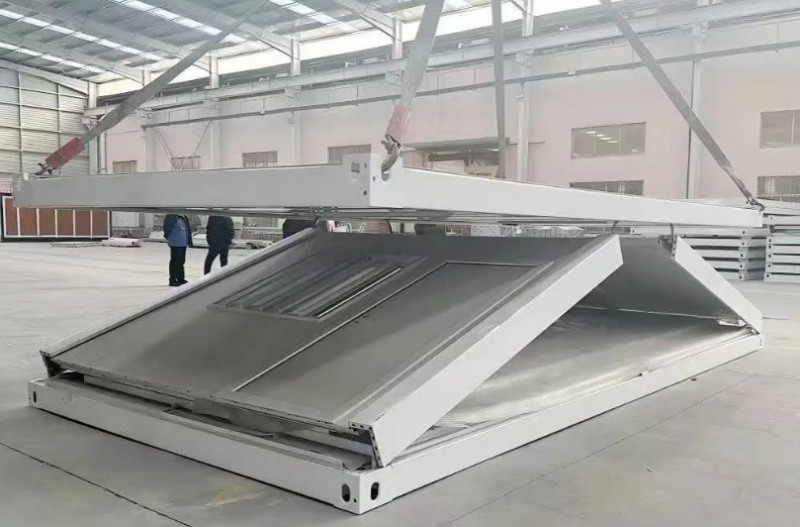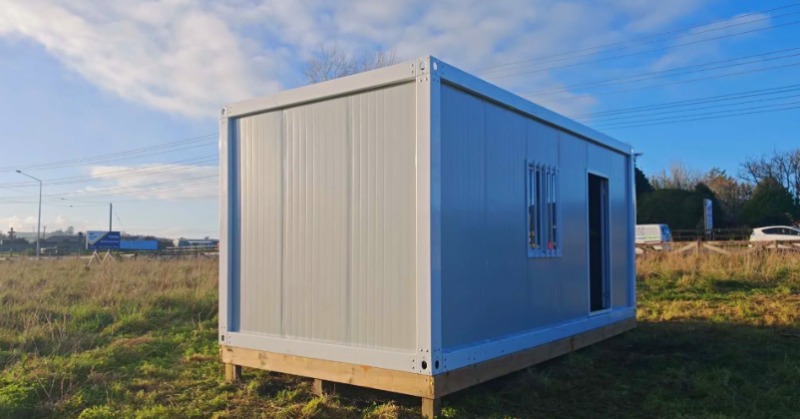- nancy@wzhgroup.com
- +86-15081877521
Are you planning to buy a container house for your project,whether for use as an office,dormitory,equipment room,or temporary campsite?When you start comparing prices among various suppliers,you might find that the unit price isn't daunting,and even seems quite reasonable.What really makes you hesitate is often the last column on the quote—international shipping costs.
For overseas buyers,cross-border shipping almost determines whether you can ultimately afford it.Traditional container houses,due to their fixed structure and large size,take up a lot of space during sea freight.A significant portion of the cost you ultimately pay is actually for the**"air"inside the shipping container**.With global logistics costs continuing to rise,this has become a"hidden time bomb"affecting project budgets.
However,the industry is changing.With advancements in modular building technology,a brand-new product is quietly revolutionizing the traditional container house transportation model—the Foldable Container House.It not only changes the way buildings are used but also fundamentally revolutionizes the cost structure of cross-border transportation.
Why can Foldable Container Houses help you save up to 80%on shipping costs?How different is it from a regular container house?This article will break down the logic behind it and help you determine which option best suits your project budget.

To understand where this 80%saving comes from,we must first look at the fundamental differences in logistics between traditional and foldable container houses.
Model Traditional,non-detachable container houses are usually"finished products"with walls,roofs,and floors pre-welded in factories.They are structurally robust,but at the cost of fixed volume.When international shipping is required,such houses must occupy a full standard container space even when empty inside.
Imagine:You rent a huge 40-foot shipping container(40HQ),with approximately 70 cubic meters of internal space,but you only load one house into it.This means you pay exorbitant shipping costs for the remaining 60-plus cubic meters of space(mainly air).In this"one container,one unit"model,logistics efficiency is a fixed 1:1,and your logistics costs are an insurmountable barrier to unit housing costs.
The advantage of foldable container homes lies in their modular design and high compressibility.They are designed in the factory as detachable or foldable parts,with the main body including the top,bottom,and four walls.During sea transport,these components can be precisely and stacked together.
After extreme compression,the height of a house can typically be controlled to around 45 centimeters.A standard 40HQ container has an internal height of approximately 2.7 meters.This allows us to easily load up to 10 to 12 foldable container homes into a single 40HQ container.This means that shipping costs are spread across more than 10 units.This 1:10 or even 1:12 logistics efficiency compared to the traditional 1:1 model,resulting in 80%savings in shipping costs,is not an exaggeration but based on solid logistics mathematics.
When buyers hear"foldable,"their biggest concerns are structural strength and durability.However,modern foldable container houses can completely rival or even surpass some traditional products in performance.
You don't need to worry that folding means unsafety.In fact,high-quality foldable houses are uncompromising in their frame materials.They still use high-strength steel for the main columns and roof beams,and professional bolt connections and locking mechanisms ensure structural stability after assembly.
Products from many professional factories(such as Gaxtent)have passed rigorous wind and earthquake resistance certifications,fully capable of withstanding various harsh weather conditions.This structural design ensures both transportation flexibility and safety in use.
For temporary projects with limited contract terms(such as mining camps,large-scale exhibitions,or phased construction projects),the advantages of foldable homes are unmatched by traditional homes.After the project ends,ordinary container homes can only be resold locally at a low price,or even require dismantling costs.
Foldable homes,on the other hand,can be quickly restored to their transport form,reloaded into trucks or containers,and transported to the next construction site for continued use,achieving asset recycling and high liquidity,greatly improving the return on investment(ROI).
Although the structure is foldable,the interior configuration can be highly professional.Modern foldable container homes are equipped with integrated circuits,embedded lighting,PVC flooring,and insulated sandwich wall panels.
This means that when delivered to you,it meets the"move-in ready"standard.You don't need to do complex secondary wiring or decoration on the project site,saving you the trouble and extra costs of on-site construction.
Foldable container homes are not a"one-size-fits-all"solution,but they do have overwhelming advantages in many specific scenarios.Before deciding whether to choose this structure,understanding when it truly delivers value can help you make the most cost-effective purchasing decisions.
Scenarios where foldable container homes are essential:
Projects located in remote or overseas locations:The longer the transportation distance,the higher the proportion of logistics costs.Once ocean freight accounts for more than 20%of the total project cost,the space saved by the foldable design immediately translates into a considerable cost difference.
Large purchase batches(10 units or more):The larger the batch,the more significant the"air transport cost"of traditional containers becomes.Foldable structures can accommodate 4-6 units in a 40HQ container,significantly improving unit transport efficiency.
Projects with temporary requirements:Projects requiring rapid deployment and dismantling are better suited to this type of lightweight,non-destructible,and reusable equipment housing.
Frequency of asset transfers:For example,leasing companies,multinational project teams,or mobile camp operators.Foldable container homes can continuously reduce transportation costs during transfers,accumulating savings over time.

Despite the significant advantages of foldable products,traditional container homes still perform better in certain use cases.To avoid limitations or additional costs during project use,you also need to understand when standard shipping containers are best suited for different situations.
Scenarios for standard container houses still need to be considered:
Extremely complex personalized modification needs:If the project involves deep structural modifications such as welding,drilling,reinforcement,and stacking,standard containers with fixed structures are easier to construct and offer better stability.
Extremely short transportation distances(within the same city or province):When transportation only requires short-distance trucking,the difference in sea freight costs due to space savings is minimal.Standard containers,with their sturdy structure and lack of need for folding,are more suitable.
Very low budgets or willingness to choose second-hand renovations:Traditional second-hand containers are inexpensive,suitable for projects with extremely high cost sensitivity,but this comes with the maintenance and safety risks associated with older structures.
As one of the few manufacturers of folding container house in the industry specializing in the research,development,production,and global export of folding structures,WZHhouse,through years of engineering experience and a rigorous manufacturing system,ensures that folding container houses are not only"foldable"but also"long-lasting.
"WZHhouse boasts professional folding mechanism R&D capabilities,going beyond simple imitation by ordinary container house factories:It possesses a mature folding hinge system and structural design,ensuring a folding ratio of 1:10–1:12,achieving maximum load capacity without sacrificing structural strength.
High-strength materials+international certification standards:Using Q235/Q355 steel,Class A fire-resistant materials,and environmentally friendly insulation layers,its products meet international market requirements such as CE and ISO,ensuring long-term stable operation in overseas projects.
Industrial-grade production lines with stable and traceable production capacity:WZHhouse has large-scale production capabilities,supporting long-term supply,multinational projects,government orders,and large-scale camp projects.
Global project experience,understanding the true needs of overseas clients:Including construction speed,local regulations,transportation methods,and installation methods,everything from design to packaging is fully optimized for export.
More than just selling products,it delivers"complete solutions":From structural design,transportation planning,installation guidance to maintenance advice,a professional team provides support to ensure smooth project implementation.
Through the above in-depth comparison,you should now understand why foldable container houses can save you 80%on shipping costs—due to their revolutionary improvement in logistics.This advantage brings tangible profit growth and efficiency gains to businesses in international trade and project construction.
Choosing foldable container houses means choosing higher time efficiency,lower logistics costs,and more flexible asset allocation.
If you are looking for a foldable container house with lower transportation costs,faster installation,and more reliable quality,WZHhouse is the most trustworthy partner.
Contact our engineering team for free technical solutions and real-time quotes to make your project more efficient and cost-effective from the very beginning.
Copyright © Hebei Weizhengheng Modular House Technology Co., Ltd. All Rights Reserved
Sitemap